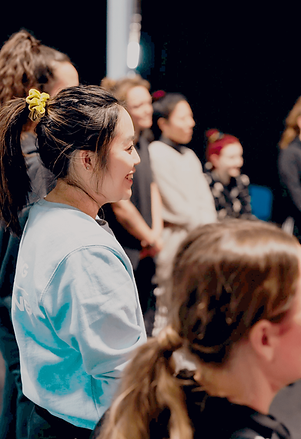
Knee ACL Injuries
What is an Anterior cruciate ligament (ACL) injury?
An ACL (anterior cruciate ligament) injury is one of the most common and challenging knee injuries, especially for dancers, athletes, and active individuals. The ACL is a key ligament inside the knee joint that helps stabilise and control movement. It connects your thigh bone (femur) to your shinbone (tibia), and plays a vital role in pivoting, jumping, and directional changes. If you suspect an ACL injury, early evaluation by a physiotherapist or sports doctor is essential. A thorough clinical assessment is often followed by imaging such as:
-
MRI to assess the extent of ligament damage and associated injuries
-
X-rays to rule out fractures or avulsion injuries
Where is the ACL Located?
The ACL is deep within the knee joint. It's part of a complex network of bones, cartilage, ligaments, and muscles that work together to allow strong, explosive and pivoting movements. The role of the struction is to is to prevent the tibia from sliding out in front of the femur, provide rotational stability during pivoting or twisting movements and support explosive power and directional changes. Surrounding structures like the meniscus, patella (kneecap), MCL (medial collateral ligament), and quadriceps muscles also contribute to knee function and can be affected when injury occurs.

Mechanism of ACL injury
ACL injuries are common and can be caused by a variety of factors such as falls, sports activities and landing accidents. The mechanism often involves a rapid change in direction, a sudden stop, landing after a jump, or direct contact with the knee.
It is useful to remember that injuries to the ACL rarely occur in isolation. The presence and extent of other injuries may affect the way in which the ACL injury is managed. Indeed, the mechanism of injury can also damage the Medial Collateral Ligament (MCL) or the meniscus. Other associated injuries could be microfractures or bone contusions, both with or without chondral injuries. This injury often causes knee pain and swelling, impacting your mobility and activities. Not all knee ACL tear requires surgery, and understanding your condition is the first step to recovery. This is why accurate diagnosis and individualised treatment are crucial.
Symptoms related to ACL injury
ACL injuries can range in severity, and there are some common signs to look out for. Many people with injury to their ACL. describe hearing or feeling a sudden “pop” at the moment the injury happens, and that’s often the first clue.
Next thing they might notice is immediate swelling and instability in the knee, and the knee may feel unstable or wobbly, making it hard to put weight on it or continue their activities. Pain tends to settle around the knee, and the swelling can take a few weeks to settle. Over time, if the injury isn’t properly managed, some might also complain of ongoing stiffness, weakness, or that dreaded sensation of the knee “giving way” unexpectedly.

What are your injured ACL treatment options?
ACL rehabilitation post-injury has undergone considerable changes over the past decade, and research supports immediate training for range of motion and weight-bearing exercises. There are many different options for treatment, depending on each stage of the injury and physiotherapy is required for both conservative and surgical options.
-
Non-surgical recovery can take 4-9 months, depending on the individual's fitness, severity of the tear, and commitment to rehabilitation and activity goals.
-
Surgery (ACL reconstruction) options involve replacing the ACL with a ‘graft’, and recovery can range from 6-12 months post-surgery.
-
A physiotherapist can guide you through your non-surgical and surgical treatment options, and progressive and structured rehabilitation (eg, pre-surgery/post-surgery options).
Other factors that may influence the treatments include patients' ages, sports activities, and, foremost, subjective instability symptoms in daily life activities should be considered when deciding for or against ACL reconstruction. In those cases, a physiotherapeutic program of complete re-gain of ROM, a comprehensive program of reinforcement and restoration of proprioception and a normal gait pattern training could be the best rehabilitation protocol. However, if symptomatic instability of the knee is not reduced after physiotherapy or after adjustment of activity, anterior cruciate ligament reconstruction is recommended. This might prevent multiple interventions because of further meniscal and cartilage damage.
Nonoperative treatment of the ACL
Not every ACL tear requires surgery. In fact, nonoperative (conservative) management can be a valid option, especially for individuals with partial tears, those with low-demand lifestyles or sports goals, patients who do not experience knee instability in daily life and growing adolescents where surgery may pose long-term risks.
If the knee feels stable during daily activities and there’s no persistent instability, a structured physiotherapy plan may be all that’s needed.
Rehab typically progresses through three key stages: acute, sub-acute (or mid-stage), and late-stage rehabilitation. In the acute phase, the priority is reducing swelling, managing pain, and regaining basic range of motion in the knee. As we move into the mid-stage lower limb rehab, we start to focus more on muscle strengthening, especially around the quads and hamstrings, along with improving power, balance and proprioception.
Operative treatment of the ACL
If the ACL is fully ruptured or if knee instability significantly interferes with daily or sporting activities, ACL reconstruction surgery may be recommended. Surgery typically involves replacing the torn ACL with a graft, using tissue from the patellar tendon, the hamstring tendon or sometimes from a donor (allograft). The choice of graft depends on your sport, previous injuries, and the surgeon's recommendation. Recovery and return to sport are subject to objective testing. The Melbourne Protocol is a widely respected rehabilitation program designed to guide ACL recovery, from the initial injury to a total return to sport.
The major goals of ACL rehabilitation:
Rehabilitation with physiotherapy after an ACL injury focuses on a few key goals. First, it’s essential to restore the full range of motion in the knee, followed by rebuilding muscle strength and improving proprioception (the body’s sense of joint position and movement in relation to space). From there, the aim is to develop strong functional stability to support everyday activities and more dynamic movements like walking, running, and jumping. Ultimately, the goal is to help you return to your highest possible level of function while also reducing the risk of re-injury. If you're curious about what that journey looks like in real life, check out this rehab case study on the ACL rehabilitation journey.
.png)
